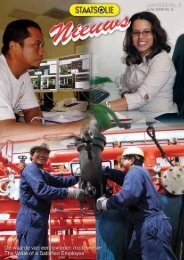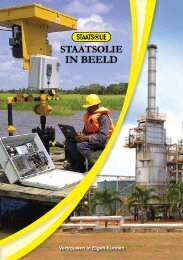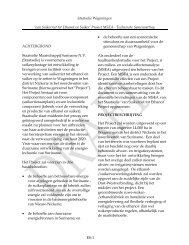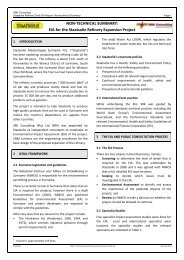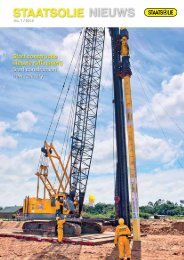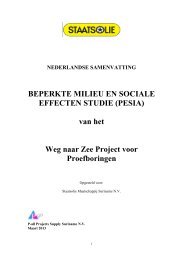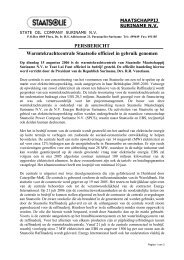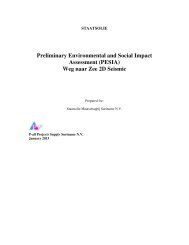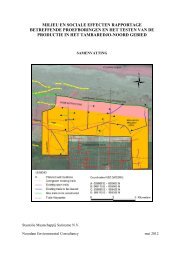concept EIA-rapport - Staatsolie
concept EIA-rapport - Staatsolie
concept EIA-rapport - Staatsolie
Create successful ePaper yourself
Turn your PDF publications into a flip-book with our unique Google optimized e-Paper software.
SRK Consulting: Project No: 439414 <strong>Staatsolie</strong> Pipeline <strong>EIA</strong> – Draft <strong>EIA</strong> Report Page 60<br />
groundwater impacts from the above sources during normal operation of the pipelines is considered<br />
insignificant 28 , as:<br />
• The pipelines are designed to prevent leakage of any product (they will have ample wall<br />
thickness, additional coating and a cathodic protection system to prevent corrosion);<br />
• The pipeline will be embedded in a clay layer with very low permeability, making it unlikely that<br />
any drilling mud will permeate to groundwater; and<br />
• The groundwater in the Zanderij aquifer underlying the pipeline corridor is brackish and not of<br />
good (drinking water) quality.<br />
It must be noted that the above assessment is based on the assumption that the following measures<br />
are implemented in the project design, construction and operation phases:<br />
• Investigation of the proposed pipeline corridor prior to the commencement of drilling to ensure<br />
that the depth of aquifers and ground composition is known along the route;<br />
• The alignment of the drill path will stay within the clay layer where possible and will not lie within<br />
the Zanderij aquifer underlying the pipeline corridor;<br />
• Ensure that the structural integrity of the pipeline is regularly and sufficiently monitored, e.g.<br />
through pigging;<br />
• Maintain the cathodic protection system in working order at all times; and<br />
• Monitor and compare product volumes entering and exiting the pipelines for indications of lost<br />
product.<br />
6.2.2 Visual impacts<br />
The visual quality and sense of place of the proposed pipeline corridor is characterised by the<br />
activities on the Suriname River and its bank. Dense (secondary) vegetation grows along the bank of<br />
the river on unused plots, while various forms of industrial structures and associated jetties are<br />
located on most of the other (cleared) plots along the pipeline route. The river is used by a variety of<br />
large cargo and smaller recreational vessels.<br />
During construction, potential sources of visual impacts include drilling equipment at the pipeline<br />
entry / exit points, activities at the pipeline assembly area, pipeline strings laid out for insertion into<br />
the borehole and construction activities along the trenching and pipe rack sections. The magnitude<br />
of potential visual impacts from the above sources is considered insignificant, as:<br />
• Most activities will take place within areas already used for industrial purposes and characterised<br />
by industrial structures;<br />
• The visual absorption capacity of the landscape is considered to be high:<br />
o Remaining vegetation is high and dense and will effectively shield the construction activities<br />
from many areas; and<br />
o Industrial structures on other plots are congruent with pipeline construction activities and will<br />
effectively absorb visual impacts;<br />
• Pipeline construction activities will mostly take place on the river bank and away from main<br />
public roads or places. As such, there will be relatively few people exposed to the visual impacts<br />
28 The risk of a pipeline rupture is discussed in Section 6.6 below.<br />
REUT/DALC 439414_<strong>Staatsolie</strong>Pipeline<strong>EIA</strong>_Draft <strong>EIA</strong> Report_Final June 2012




